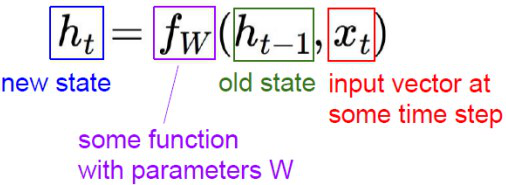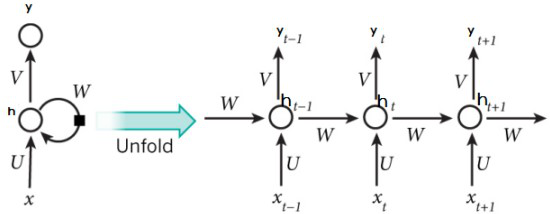实验原理:
RNN的网络结构及原理
RNNs包含输入单元(Input units),输入集标记为{x0,x1,...,xt,xt+1,...},而输出单元(Output units)的输出集则被标记为{y0,y1,...,yt,yt+1.,..}。RNNs还包含隐藏单元(Hidden units),我们将其输出集标记为{h0,h1,...,ht,ht+1,...},这些隐藏单元完成了最为主要的工作。
它的网络结构如下:

各个变量的含义:

展开后:

其中每个圆圈可以看作是一个单元,而且每个单元做的事情也是一样的,因此可以折叠成左半图的样子。用一句话解释RNN,就是一个单元结构重复使用。
RNN是一个序列到序列的模型,假设xt-1,xt,xt+1是一个输入:“我是中国“,那么ot-1,ot就应该对应”是”,”中国”这两个,预测下一个词最有可能是什么?就是ot+1应该是”人”的概率比较大。
运行代码:
import numpy as np import tensorflow.compat.v1 as tf from tensorflow.python.ops import rnn from tensorflow.examples.tutorials.mnist import input_data import os os.environ["CUDA_VISIBLE_DEVICES"]="0" tf.disable_eager_execution() #保证sess.run()能够正常运行 mnist=input_data.read_data_sets("MNIST_data",one_hot=True) #Training Parameters learning_rate=0.001 training_steps=10000 batch_size=128 display_step=200 #Network Parameters num_input=28 timesteps=28 num_hidden=128 num_classes=10 #tf Graph input X=tf.placeholder("float",[None,timesteps,num_input]) Y=tf.placeholder("float",[None,num_classes]) # Define weights weights={ 'out':tf.Variable(tf.random_normal([num_hidden,num_classes])) } biases={ 'out':tf.Variable(tf.random_normal([num_classes])) } def RNN(x,weights,biases): x=tf.unstack(x,timesteps,1) #define a lstm cell with tensorflow lstm_cell=tf.nn.rnn_cell.BasicLSTMCell(num_hidden,forget_bias=1.0) #Get lstm cell ouput outputs,states=rnn.static_rnn(lstm_cell,x,dtype=tf.float32) #Linear activation ,using rnn inner loop last output return tf.matmul(outputs[-1],weights['out'])+biases['out'] logits=RNN(X,weights,biases) prediction=tf.nn.softmax(logits) #Define loss and optimizer loss_op=tf.reduce_mean(tf.nn.softmax_cross_entropy_with_logits( logits=logits,labels=Y )) optimizer=tf.train.GradientDescentOptimizer(learning_rate=learning_rate) train_op=optimizer.minimize(loss_op) #Evaluate model(with test logits,for dropout to be disabled) corrent_pred=tf.equal(tf.argmax(prediction,1),tf.argmax(Y,1)) accuracy=tf.reduce_mean(tf.cast(corrent_pred,tf.float32)) #Initialize the variables init=tf.global_variables_initializer() #Start Training with tf.Session() as sess: # Run the initializer sess.run(init) for step in range(1,training_steps+1): batch_x,batch_y=mnist.train.next_batch(batch_size) # Reshape data to get 28 seq of 28 elements batch_x=batch_x.reshape((batch_size,timesteps,num_input)) #Run optimization op sess.run(train_op,feed_dict={X:batch_x,Y:batch_y}) if step % display_step ==0 or step==1: #Calculate batch loss and accuracy loss,acc=sess.run([loss_op,accuracy],feed_dict={X:batch_x,Y:batch_y}) print('Step'+str(step)+" ,Minibatch Loss"+"{:.4f}".format(loss)+",Training Accuracy="+"{:.3f}".format(acc)) print("Optimization Finished!") #Calculate accuracy for 128 mnist test images test_len=128 test_data=mnist.test.images[:test_len].reshape((-1,timesteps,num_input)) test_label=mnist.test.labels[:test_len] print("Testing Accuracy:",sess.run(accuracy,feed_dict={X:test_data,Y:test_label}))
运行结果:
